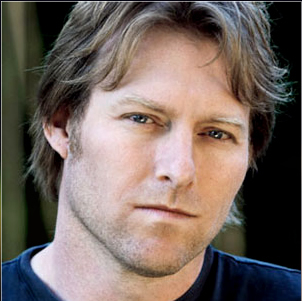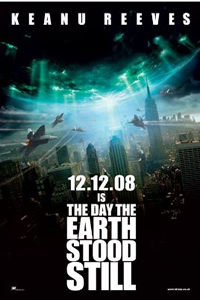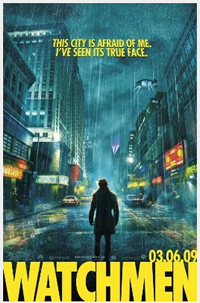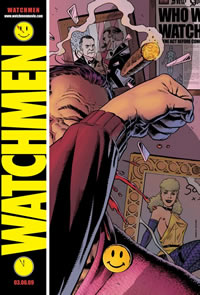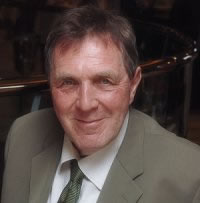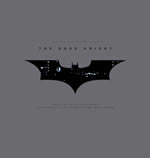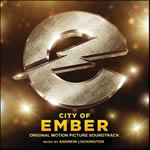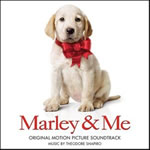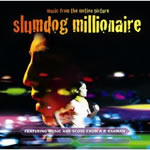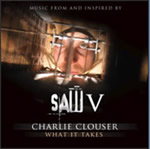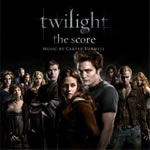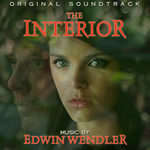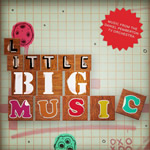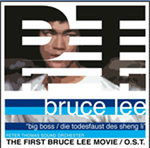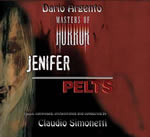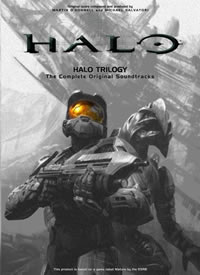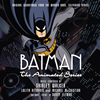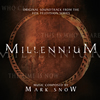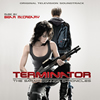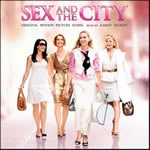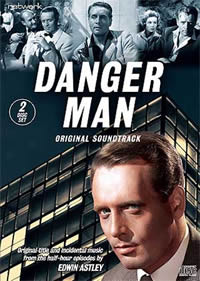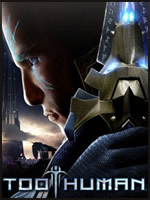 |
Soundtrax: Episode 2008-22
December 15th, 2008
By Randall D. LarsonRorschach Test: Tyler Bates’ Musical Delineations of Klaatu and Watchmen
With The Day the Earth Stood Still and Watchmen, the latter completed but held for release until March, Tyler Bates has lent his musical hands to two of the most significant films of his filmography thus far. The Day the Earth Stood Still is one of the all-time classic science fiction films of the1950s, and universally recognized for its themes of peace and peacemaking. Watchmen, even as a graphic novel, was recognized in 2005 by Time Magazine as one of “the 100 best English-language novels from 1923 to the present,” the only graphic novel to attain such acclaim. Bates rejoins director Zach Snyder (300, Dawn of the Dead remake) on Watchmen, collaborating on a unique yet faithful vision of this classic piece of storytelling. Interviewed on December 8th, Bates described his efforts to support the bringing to cinematic life both of these iconic works of pop culture through his musical scores.Reviews this week include Warner Bros.’ 2-disc expanded soundtrack of Hans Zimmer & James Newton’s score for The Dark Knight (The duality inherent in both film and score are equally reflected in this 2-disc edition, which provides two faces of the Dark Knight score – one revealed with the bright glow of a darkness-piercing searchlight, the other squirming in shadows, expressing its subtly in the murky unglowing darkness), Andrew Lockington’s City of Ember (“a fine score, richly orchestrated and beautifully conveyed in a persuasive old fashioned fully symphonic idiom”), Theodore Shapiro’s gentle comedy score for Marley & Me (Lakeshore gives the score’s rhythmic lyricism and harmonic nuances plenty of room to frolic, and allows Shapiro’s gift for scoring comedy with a heartfelt human spirit to shine), A.R. Rahman’s Slumdog Millionaire (“the music is primarily in a world-beat mode, incorporating urban riffs and rhythms and a distinctly ethnic texture, but it remains extremely compelling in both its action oriented material and it’s street-music”), a pair of downloadable singles from Charlie Clouser’s latest score for Saw V (some of the most potent and energetic horror music of the last few years), Carter Burwell’s score for the trendy vampire romance, Twilight (“captures the film’s vampiric sensibilities with a rushing air of percussive rhythm but allowing the story’s predominant romantic notions to set the more pervasive tone”), Edwin Wendler’s internet series score, The Interior (“an intense and ambient work that provides a tonality of unease and disturbiana”), Daniel Pemberton’s video game score Little BIG Planet (“enchanting and quirky and delightful, rooted in the quirky diversity of Mothersbaugh and Curtin and other various creators of wonderful television cartoon music”), Peter Thomas’ archival release of his music for the English-dubbed version of Bruce Lee’s The Big Boss (“a rock/pop based score not unlike those heard in European cop movies of the era”), an Italian release of two episodes of Claudio Simonetti’s music from the Masters of Horror cable series (“both finely crafted horror scores nicely presented… both utilize female voice to haunting effect…”), and a box set of game scores from the popular Halo game series (“all three scores are a heady mixture of orchestra, synth pads, and driving rock and roll guitar work, crafting a highly satisfying mixture of dramatic atmospheres”)
.
Tyler Bates Rorschach Test: Musical Delineations of Klaatu and Watchmen
With The Day the Earth Stood Still and Watchmen, the latter completed but held for release until March, Tyler Bates has lent his musical hands to two of the most significant films of his filmography thus far. The Day the Earth Stood Still is one of the all-time classic science fiction films of the1950s, and universally recognized for its themes of peace and peacemaking. Watchmen, even as a graphic novel, was recognized in 2005 by Time Magazine as one of “the 100 best English-language novels from 1923 to the present,” the only graphic novel to attain such acclaim. Bates rejoins director Zach Snyder (300, Dawn of the Dead remake) on Watchmen, collaborating on a unique yet faithful vision of this classic piece of storytelling. Interviewed on December 8th, Bates described his efforts to support the bringing to cinematic life both of these iconic works of pop culture through his musical scores.
Part 1: Movement While Standing Still
Q: How did you get involved with The Day the Earth Stood Still?
Tyler Bates: Scott Derrickson, the director, called me and talked to me about his take on the movie, and his passion for the original film, which we share. He supported more of a, I wouldn’t say left of center, let’s say an artisan approach to the score.
Q: So he was attracted to you from your previous work that he was familiar with?
Tyler Bates: Yes. Strangely enough, of my work, Devil’s Rejects and Slither had the most profound effect on him, of my work! It was cool.
Q: How do you approach a film that remakes such an iconic classic of science fiction and science fiction music? Did this put you in any kind of a daunting position?
Tyler Bates: It seems like a lot of the films I work on kind of carry that weight! The expectations of what the music should be for many of the films I do is probably something that’s next to impossible to satiate for most of the hard-core fans. But you can’t let that get in your head. What you have to do is get a feeling, not what the idea of the film is but what the film itself is. You do the best thing you can for the film, and serve the director’s vision. That’s really how I have to approach it. I can’t think to myself, Oh my God, Bernard Herrmann did the original… I don’t expect to ever exist in a paradigm close to his stature, so I can’t even think about that. My approach was just to get into it and understand what Scott wanted to communicate, because its message that is slightly different than that of the original, which you kind of have to expect that, fifty-seven years ago. I mean, we got that on Halloween when Rob Zombie and I did that. People revere an original property and feel that it’s sacred, but frankly, with The Day The Earth Stood Still, there’s a good story to be retold, as it applies to the climate of the world now. If that’s something beyond the scope of a person’s ability to take in, on a new level, without using the original as a criteria for whether or not they’re going to enjoy it, then they probably shouldn’t bother themselves with it.
Q: So what elements of the new film became central to your score, and how did it develop thematically and orchestrally?
Tyler Bates: I went to visit Scott up at the set in Vancouver and I got a feeling just from watching them film a couple scenes with Keanu and Jaden Smith. I watched several dailies, and I came back and was just experimenting on my GuitarViol with delays and loops and just creating a feeling. It was not intended to be the score, but I just happened to record this one passage into my computer. A couple months later Scott came over to my studio and I played him this thing, and his eyes lit up and he said, “I think that’s the score!” Well that presented an incredible problem for me because the actual piece had a sound that I couldn’t replicate, it wasn’t in time, and it was a little distorted. But he wanted me to base the score off the feeling of the movement I’d created in this loop. We did that and it turned out to work out really well and spawned a number of thematic ideas for the film. My goal was to bring a sense of human spirit and soul to the music, and that’s been a challenge. Keanu has appeared in so many genre roles of this nature, and I also wanted to feel like it was a new experience with him as an actor in this role, so it was a matter of also creating an environment that we hadn’t quite experienced with him on screen before, so that took some handiwork and experimentation with electronic development. And we had to include the Theremin! It’s not so much a literal expression of the Theremin as in the original, but it’s very richly used throughout the score as far as textures are concerned. A lot of the ghostly ambiances throughout the film are layers of Theremin performances and then there’s some melodic material. Sometimes you can’t quite tell the difference between the Theremin and our solo vocalist, Nan Vernon, so it’s kind of interesting, actually.
Q: How did you use the vocalist as a texture of the score?
Tyler Bates: Nan has this natural ability and she transcends the term ethereal. It’s not something she has to conjure up, it’s just her state of being. She’s amazing. She’s a fan of the original movie so when I talked to her about it she was just very happy to get involved. Her voice is not unlike the Theremin but she’s expressing or underscoring some of the more emotional moments, and I think she’s able to do it without being poignant. I don’t think the vocal is ever truly a solo or lead instrument, but she’s definitely enhancing the orchestra in expressing certain counter melodies to what the strings are often playing. She’s definitely brought, in my opinion, more of the authentic ethereal sort of otherworldly quality to the music.
Q: The story has a kind of duality where we have this alien who initially seems very threatening but turns out to be something of a benefactor, yet he has this incredible power and he has this dangerous robot, Gort. How did you handle some of those subtexts and craft your score thematically and motivically around those lines?
Tyler Bates: For the most part the score is driven by the character of Helen, played by Jennifer Connelly. As the story even begins, unrelated to the plot, she is going through a series of personal challenges in her life, so the stuff in the core of her is already an emotional element in the score. She’s also a scientist, so her connection with Klaatu is one of wonderment and awe as well as dread, because I think there’s nobody who understands more than she what’s really potentially going to happen in the film. The thing was to try and not necessarily oversell Klaatu as the bad guy, so to speak. Gort is a more than threatening presence, and we’re not quite certain what’s going to happen with Gort. The cards are always face down with that character in the film.
Q: How did you treat Gort, musically?
Tyler Bates: Dark and heavy, but there’s some interesting atmospheric material. We didn’t want to make a cartoon of this movie, so most of the dynamics and emotions are steeped in human emotions. I’m not really trying to oversell the outer space elements.
Q: How much time did you have to complete the score?
Tyler Bates: It was a very compressed schedule, at the end. Initially it was to be a few months, but the picture that I initially got and where we ended was a little bit different, and there were a substantial amount of adjustments made, I would say, in September. We recorded the first week of October, so preparing the music in a very comprehensive fashion that quickly can be rather challenging, and induce lots of sleeplessness!
Part 2: Music for Doctor Manhattan & Friends
Q: You reunited with Zach Snyder on Watchmen. How would you describe your approach or what Zach had asked for, musically, on this score?
Tyler Bates: Zach never verbalized what he is looking for, or never did with me, anyway! If he does, he’ll only say something about a dramatic beat or something about a character, but he’s never really say “this is what the score should be.” I read the graphic novel only after he asked me to do the movie; I hadn’t read it before. It was heavy when I picked it up, but it was about twice as heavy when I finished reading it! I realized how much gravity this novel held…
Q: And, like with The Day The Earth Stood Still, its fans will have expectations as to how it’s treated, cinematically.
Tyler Bates: Yeah, and I can’t realistically think that I’m going to meet the expectation of the hard-core fans, but, again, it comes down to: what is the movie that Zach has made? He’s done a great job of really putting that book on the screen, like he did for 300. There are thirteen songs in the movie, and then they have a piece of music by Philip Glass, so that’s fourteen pieces of music – so you’d think, okay, if there’s fourteen pieces of music maybe there’s not so much heavy lifting for the score to do. But there’s still about eighty five minutes of my score. The characters in Watchmen are so lonely. That’s not the only bent of the score, but it definitely lives in that human dynamic a little bit more. I don’t know that most of these characters really care for each other on an emotional level, but they are bound to each other and because of that, and because of the life they pursued, they ended up fairly lonely. They’re ostracized somewhat from society, they’re defunct for the most part, and they have no friends because they’ve led a life of secrecy, so even though they thought they’ve led a life of importance and philanthropy, they’ve all ended up in a place where that’s become somewhat meaningless. The majority of the music is steeped in those emotions and not really bound to the traditions of superhero music by any stretch of the imagination.
Q: The whole story turns the notion of superheroes on its head anyway.
Tyler Bates: Yeah. That’s not really the angle, as far as the film is expressing that the superhero aspect of it, but it is a dimension of their characters. We do have a few moments of glory, though.
Q: What were Zach’s thoughts for the music of Watchmen?
Tyler Bates: It was kind of funny, because one of my score cues is going to be a b-side for a My Chemical Romance 12” vinyl single, one of those picture discs they’re putting out. It’s for one of the more aggressive scenes in the film, and I played it for Zach. We were on the dub stage and he listened on headphones. I said, “So what do you think?” And he said, “Oh, it’s awesome!” I said, “It wasn’t too heavy, was it?” He said, “Is there such a thing?” Which is pretty funny. Zach is able to embrace and express the full range of emotions on the most extreme level and do so with an extreme level of proficiency and elegance at the same time.
Q: Reading the graphic novel, there’s this heavy, weighty atmosphere that seems to hang over the story throughout. Did that figure into your scoring approach at all?
Tyler Bates: There is this weight in the music, throughout, and it depends on the perspective through which the story’s being told at any given time, because we have, basically there are four characters where we get a real backstory, and their character development is very thorough in the film. So if we’re experiencing some of Rorschach’s thoughts, or anything that he’s involved in, he sees the world through a lens of complete filth, I don’t think anybody is safe from that particular judgment by him, so there is this grimy feeling to the music when it’s his scene. Laurie is a little more emotionally fractured and yet there’s a glimmer of hope for something good, she hasn’t completely written the whole thing off yet. So there is something bereft in the music that supports her throughout the film, but there are moments of wistfulness and humor and joy.
Q: To what extent have you treated these characters thematically throughout the score?
Tyler Bates: It’s always more my approach to try and capture and express or enhance the essence of a character in a film, as opposed to leitmotifs throughout. But there is a recurring feeling or theme, as far as the texture and the overall sound in the chords and just the feeling that goes with each character, so you’re well aware of whose perspective we’re in at the time, but it’s not like every time Dan’s on screen there’s the Dan melody and we come back to the same piece of music. This story, basically, is the unfurling of the lives of everyone, and it has a great impact on humanity as well, so to stay in the same place wouldn’t make sense. The way the story’s told, there are periods – I would call them vignettes – where we’re really doing the backstory on given characters and the experiences in their lives that has shaped their characters. So I think it’s very difficult to stay within recurring themes and make them applicable to the story and allow it to move forward if it does. I will say there is an inherent perversion of pop culture in the music, through, just like history and pop culture are twisted in the film.
Q: How did you skirt around the songs? Were they just like posts you had to maneuver around, musically, or was there any relation with what you were doing in your score coming in and out of those songs?
Tyler Bates: It depended. I definitely transitioned in and out of a lot of the songs and so that’s something I had to think about. It wasn’t necessarily always to be a seamless transition, because sometimes we want that song to really cut, so the job of the score is to make sure that when that song comes in it’s a real cleansing of the palette, or it’s real beat that propels us forward – or backward, depending on what the dynamic needs to be. There are a couple of scenes where there’s a gradual transition from one sequence to the next, the picture doesn’t become blurred, but the mind-state from one scene transitions to the next and with it the music does, and sometimes in that next scene it might be a source cue, and it may require that I don’t break the thread of that thought. So I have to transition into it somewhat seamlessly, and that was an interesting challenge. I thought it was cool, though. It was a lot more fun to work with those transitions than I originally anticipated.
Q: Now, on both this and on Day The Earth Stood Still, were you working mainly on your own or did schedules require that you bring in help to get everything done?
Tyler Bates: My orchestrator, Tim Williams, lives next door to me, and we’re very close. It’s not typical that I would bring in someone else. On anything I would do for Zach I get on board before he starts filming so that I can handle every note of the music. We always try and make that the case. It’s not my desire to run a shop of writers, but when you’re working on films that are huge – and they’re all huge to me! – but when the studio side of it and the production side of it is huge, the schedule can be enormously challenging considering the scope of the work that you have to deliver. It’s a lot or work to do 90 minutes of music, and if the picture is changing up to the moment that you need to record your score, and then even after you’ve recorded and then you have to deliver your score so you have to make adjustments to the recorded music so that it’s working well with the new picture, you need support. There’s no way around that. I would never want anyone to have the perception that I’m a one-man band. I’ve had my associate Wolfgang Matthes with me over the last eleven years and he’s been my partner in the electronic development and we he’s mixed a lot of the scores with me, and he’s been a real brother. But, music’s so personal to me, and what I want to do is to ensure that the best quality music, at the end of the day, is what is in the film, given the circumstances. Believe me, a lot of people go in to see movies and say, “oh, if I was in L.A., I would have done it this way!” but it’s like, look, when you have about 45 minutes to write a 2-minute cue and get it orchestrated and get it ready for the stage the next day, you do your best! You may need people that you know and trust and who understand you long before you get to the point where you actually need it. So that’s the way to create a cohesive sound and I try to keep a very consistent culture in my life and in my work. I get people contacting me every day who will work for me for free, write for me. I don’t really try and open myself to that. I have a few people who are very close to me who are hugely talented and we have fun working together and really respect each other, and that’s what it’s about. We try and maintain the enjoyment regardless of how hectic the work becomes, but we’re all committed to challenging ourselves and doing the best work we can. I trust Tim Williams, and if I need him to rework some music that I’ve done to make it work with a new picture, in an extreme situation, I’ll call on him to do it, and he’s always been fantastic about it. But the m.o. is to just try and do it the old fashioned way.
Q: How have you integrated orchestra and electronics on the Watchmen score?
Tyler Bates: You know, strangely enough, there are a number of purely orchestral pieces in the film. Even my electronic stuff is not what people think electronic stuff is, because I don’t use plug-in synthesizers and that kind of stuff. I do have a lot of synths, but they are modular synthesis and that, to me, is just as organic as the orchestra. So there are definitely some big, long orchestral pieces that are emotional, and they have a tendency to drift from modern day 80s to 40s, so there’s this kind of a nostalgic feeling in certain sections of the music. And then there’s some really crazy non-orchestral stuff that’s electronic; some of it is definitely embracing the 80s, especially when a lot of the digital stuff started coming out, so we had some fun with that. I really don’t think I’ve done anything like Watchmen, as far as the score’s concerned. I’m just really happy about it. And then Lisa Papineau, who was my bandmate years ago in the band Pet, she was the vocal colorist on the score, and that was really nice to work with her again. She did a fantastic job and just brought another level of atmosphere and emotion to the music. And I played a bit of guitar on the score as well.
Q: So what’s next for you? I understand you’re back with Rob Zombie on El Superbeasto and Tyrannosaurus Rex after that?
Tyler Bates: I’ll be with Rob in about an hour! We’re just working on something for his new record. Tyrannosaurus Rex is not actually his next movie, but he has one happening, although I don’t think it’s my place to say what it is yet, but we’re already in the preliminary stages of working on that. El Superbeasto is done, already, and then I’m working on Tales of the Black Freighter, which is the companion piece to Watchmen, it’s the comic that is read by a character in the graphic novel – it’s been made into an animated short that will ultimately be included as part of the Ultimate Watchmen some day when they put it out on DVD. It will be like the director’s cut with that integrated into it. So I’m doing that, and working with Rob, and have a few other things, thankfully, coming up, so I can knock on wood every day that I have work!
Many thanks to Tyler Bates for his making himself available for this interview in the midst of a very busy schedule; and thanks also to Lisa Bates for facilitating our interview.
Silent Baton: Derek Wadsworth
British musician/composer Derek Wadsworth has passed away. Wadsworth worked on several feature films as arranger/conductor including the Hollywood movie Dick Tracy, Nicholas Roeg’s The Man Who Fell to Earth, Lindsay Anderson’s Britannia Hospital and The Whales of August with Bette Davis, Lillian Gish and Vincent Price and the Japanese film Swallowtail Butterfly, and others, including many corporate films, but he was perhaps best known as a composer for his great score to the second year of the TV series Space: 1999. Wadsworth also worked on other Gerry Anderson productions such as The Day After Tomorrow as well as the British TV series The Fame and Shame of Salvador Dali, The Life and Crimes of Elmore Leonard, The Seven Wonders of the World, Pickwick Papers (arranger to Carl Davis), and others.
See: www.derekwadsworth.com/
Here are his main titles for SPACE: 1999 Year II
And a rarely seen alternate version
New Soundtrax in Review
Just in time for the DVD and Blu Ray releases of the movie, Warner Bros. has released a 2-disc Special Edition of the soundtrack to The Dark Knight, expanding the intricate Hans Zimmer & James Newton Howard score by another 50 minutes, supplemented by a quartet of remixes and a 40-page hardbound book with photos from the movie. Disc 2 is identical to the initial soundtrack release of the score, which remains a very satisfactory amalgamation of the score’s central and essential elements (reviewed in my July 30th column). The ten new tracks are presented on disc 2, followed by the remix tracks, which allows for a more in-depth presentation of extended renditions or variations on the main cues. “Bank Robbery (Prologue”) opens the new disc with a pensive rhythmic mysterioso for the film’s opening robbery sequence in which we first meet Heath Ledger’s brilliant interpretation of The Joker. It’s low-key and unessential material, but effectively brooding suspense music. “Buyer Beware” introduces Zimmer’s rhythm-heavy Batman theme (very elegantly, albeit darkly, reprised again in “Chance”), while “Halfway to Hong Kong” resonates with a dark clarity as it crafts much of the psychological underpinnings that the Bruce Wayne/Batman characters wears like an iron cloak. The score, as I noted in my initial review, is an overture of dualities, clearly manifested in its initial release; in the additional material presented on this Deluxe Edition, the composers’ subtler treatment of these contexts and subtexts are more intricately nuanced and felt in more drawn-out measures. “Decent Men in an Indecent Time” eloquently portrays this idea, crafting a kind of tone poem for integrity as it falls under submission to the harsh realities of a cruel world. The cue deconstructs what it is to compose a mighty heroic theme such as has graced Superman or The Fantastic Four, and instead conveys the twisted darkness that necessarily dwells within the honest heart of a do-gooder existing in a less than perfect world. “You’re Going To Love Me” reprises the slow climbing siren sound of “Agent of Chaos” on Disc 1 before raging out of control, the eventual crescendo depicting Joker’s rising madness reaching its peak and expressing its climax in a rage of violence and percussive dissonance, while ending on a note of eloquent poignancy; a tragedy of humanity, a soul torn apart by megalomaniacal madness. “You Complete Me” exudes a fragile intensity of harsh quietude, broken by segments of the main theme’s rhythmic elements, lurking beneath its somber and segmented riffing before opening into a full and powerful rendition of the Batman theme. The 10-minute “The Ferries” constructs a hyper-dramatic rhythmic tension, built largely out of the Batman Theme with the low undercurrent riffing of “Bank Robbery” and “You Complete Me”, behind the scene where a pair of harbor passenger ferry boats are threatened by The Joker in one of the film’s most dramatic and moving sequences. “We Are Tonight’s Entertainment” embodies the attack on the gala party and progresses through a variety of elements, from the Batman’s broodingly heroic motif through Joker’s industrialistic siren of musical ascension, and “A Watchful Guardian” concludes the score with grand, melancholic measures of distraught heroism, wherein the main theme is inflected with as much a sense of personal tragedy as it is with honor and heroism, although in the end, the music – as the character – chooses to embrace its dark circumstances, and triumph heroically, if unrecognized and disrespected, its honor and integrity intact, even if no one notices. Interestingly, at the end, it’s Joker’s rising motif that ends the score; a final code reflecting at whose hands much of the story’s tragedy has taken place.
The rhythmic, textural, and fairly nonmelodic basis of the score lends itself to the quartet of remixes that are included as bonus tracks on the disc. Noted electronica artists The Crystal Method, Paul Van Dyck, Mel Wesson, and Ryeland Allison each take a track and reinterpret it, extending and heightening its rhythm and adding all manner of new textures and riffs. The result is uneven but interesting and gives the score a kind of Matrix revisitation – Gotham City interpreted through the beat-heavy riffs of house and electronica (Van Dyck’s danceable beat-laden version possibly the best of the four with its throbbing reflection of Dark Knight’s main theme).
Getting back to the score itself, though: consider Disc 1, and the initial soundtrack release, as the more straightforward representation of the score’s most essential elements. Disc 2, the main draw of this fairly expensive Deluxe Edition, to be a subtler extension of that, with more nuances expressions and notably undercurrents of the score. It fills in the darker gaps that existed between the peaks of Disc 1’s presentation. The duality inherent in both film and score are equally reflected in this 2-disc edition, which provides two faces of the Dark Knight score – one revealed with the bright glow of a darkness-piercing searchlight, the other squirming in shadows, expressing its subtly in the murky unglowing darkness. The whole character, as does the whole score, depends upon both faces to voice its full temperament and integrity.
Andrew Lockington (Skinwalkers, Journey To The Center of the Earth; see interview in my July 30th column) has provided an energetic and adventurous score for City of Ember, Gil Kenan’s adaptation of the Jeanne DuPrau fantasy adventure novel about a self-contained underground city whose power source, the glittering lights that illuminate its world, begins to fade. Lockington’s score is a rich and eloquent symphonic composition performed by a 90-piece orchestra and 85-voice choir, enhanced by what Lockington describes as “unique percussion elements accented by mystical wind instruments that can only be compared to whale music.” The score is very full-blooded, quite majestic and dramatic. Released on CD by Bulletproof Records, the Main Title opens the score with a muscular rush of horns, prodded onward by insistent air carvings from violins and massive layers of choir, providing a provocative and dynamic cadence for the city’s power, size, and the urban dynamic of its people. The main theme for the score is embodied in that for the main female character, 12 year old “Lina Mayfleet.” Driven by the strings that opened the score, her theme shares equal association with the City of Ember itself, both eloquent and proud, reflecting an honorable heritage and self-assurance. Another theme is associated with Ember’s Mayor, keeper of the secret of the lights, corrupt and incompetent, encapsulated by a brooding mysterioso, dark and somber, very much in contrast with the brightness of the City theme. Lockington’s marvelously intoned brass section is enhanced by what he describes as “the 4 Wagner Horns who lend their bold signature to the score’s main theme.”
“The Box of Ember” is a progressive mysterioso of elegant harmonic chords, building an effective atmosphere from strings and woodwinds, associated with the sacred box in which the city’s builders have housed instructions for reactivating the dying lights of Ember. A clipped, fast-paced percussive motif, introduced in “Job Exchange” and developed as a consistent undercurrent of rhythm for “Blackout,” like a metronome on hyperdrive. Choir is put to nice use in “Proof,” intoning quietly and adding a mysterious dimension to the cue’s atmosphere. “Room 351” contains some impressive violin figures beneath choir that emanate out of the metronome and horn thematic material, resonating stridently across statements from French horn. “Fugitives” also gives the string section a workout, punctuated by horns and choir and plenty of pounding drums as fragments of themes intersperse with the jagged edges of the fast-paced violin bowing. This action cue recurs frequently, as in the splendid clarity of the trumpets in “Lori’s Bike” reflecting off the pattern of frenzied violins. The main theme also has plenty of opportunities to soar eloquently, as in the score’s showpiece, “Clockworks,” with a powerful series of clear-toned brasses and rhythmically recycling violins, embellished by choir. The smooth tonal texture of the score is very appealing, and Lockington’s mastery of the large ensembles and their melodic interaction is very fine. “Water Wheel” is a little more chaotic, presenting itself as a massive action/battle cue with a tremendous display of clashing orchestration. In contrast with the score’s majestic tonality if the reflective atonality of “Stalagmite Trance,” which eventually culminates in a fast ascent of entwined violins, crescendoing in a smooth glissando in very high register. The score culminates beautifully with the bright “Escape to Sunrise,” which develops over its 5-minute length into a grandiose and splendidly triumphant denouement, with the eloquent coda of “One Last Message” providing a fitting recapitulation of the score’s major themes. City of Ember is a fine score, richly orchestrated and beautifully conveyed in a persuasive old fashioned fully symphonic idiom.
See: www.andrewlockington.com
Theodore Shapiro’s latest score, for Devil Wears Prada director David Frankel’s gentle family film, Marley & Me, to be released next week by Lakeshore, is everything you’d expect from a gentle comedy about a family who learns important lessons from a neurotic dog. Primarily acoustic, with attractive, breezy melodies and rhythms, the score is appropriate, effective, and likeable, even if it’s fairly predictable and tugging at the melodic heartstrings and happy feelings. The score is in the exuberant Benji-idiom of contemporary lovable pet music, but within that contest it works fine; it’s quite reminiscent of the style of Bruce Rowland with lots of acoustic harmonies driven by an omnipresent pop-laden drumbeat. The score doesn’t need sweeping choruses or intricate, dramatic arpeggios; Shapiro supplies a brisk arrangement of cheery rhythmic melodies, built around a cool pop theme best explored in “Two Year Montage” and the end title track, “Marley & Me,” which houses a compelling keyboard tonality above which guitars, piano and drumkit flow with a very catchy melodic motif. You can’t help but break into a grin with this contagiously charming music, even at its most innocuous. “First Sleepless Night” is a neat comedic track, housing a variety of tunes and arrangements supporting what sounds like a very funny sequence, while “When It’s Time” and the heartfelt obviousness of “Lost in the Rain” and “Jen Says Goodbye” resonate poignantly with dramatic shades of melancholy or tense melody. “Off To Ireland” captures strong flavors of Irish music in its flowing rhythms that bring the characters to the emerald isle in a kind of Dog of the Dance sensibility. “Heading Home” wraps it all up in a happy and joyfully triumphant musical conclusion. With 24 tracks squarely set in the melodic pop idiom, Marley & Me is a cute and a fun soundtrack, nicely preserved on this songless disc, which gives the score’s rhythmic lyricism and harmonic nuances plenty of room to frolic, and allows Shapiro’s gift for scoring comedy with a heartfelt human spirit to shine.
Bollywood music legend A.R. Rahman provided score and songs to the new Danny Boyle (28 Days Later) dramedy, Slumdog Millionaire. The score, and songs, have been released by Celador Films as an iTunes download. The music is primarily in a world-beat mode, incorporating urban riffs and rhythms and a distinctly ethnic texture, but it remains extremely compelling in both its action oriented material and it’s street-music. “Mausam & Escape,” for example, develops a cool riff into a propelling action chase, featuring as much sitar, tablas, and guitar as it does Hollywood-styled action synth, men’s choir, solo female voice, and drumkit. “Latika’s Theme” is a lyrical theme with a very pretty melody sung by female vocalist over strings and sitar. “Millionaire” is a straight-ahead riff driven by house music dance beat and various measures taken by synths and samples. “Riots” is a chaotic action cue incorporating some interesting found sound, as in the chainsaw-starting-up roar that recurs as a sampled riff throughout the tune, and much reflective percussion and hand drumming, serving up an interesting platter of percussive energy and drive. “O… Saya,” the vocal song that opens the album (written by Rahman with British-born Sri Lankan songstress M.I.A.), is a likable atmospheric tune with a predominant Indian beat, although most of the other songs (written by M.I.A. and a host of other modern songwriters and rappers) are less interesting to me. The album also reprises the neat modern Bollywood hit, “Aaj Ki Raat,” originally written by Shankar, Loy, and Ehsaan for Farhan Akhtar’s 2006 Bollywood action thriller, Don.
Former Nine Inch Nails keyboardist Charlie Clouser returns to the Saw horror franchise with his rough-edged and rusty music for the latest trap and torture fest, Saw V. Two tracks have been released by Artists Addiction as separate singles available for download from iTunes – although a score album CD or download will probably show up eventually, as it has for most of the previous Saw scores. The two Saw V tracks, “Trap Attacks” and “What It Takes,” are both very interesting electronica-based horror cues, the former a severe, pounding/slashing rhythm track, all horrific action and threat and in-your-face onrushing assault, the latter is a subtler and more melodic track emphasizing the confidence a protagonist needs to fight back against the relentless horror extant in the former track. They make a very good match. Clouser’s music for the Saw films has been some of the most potent and energetic horror music of the last few years, and I’m pleased to see these tracks released from Saw V.
Carter Burwell’s score for Twilight, the trendy beautiful peoples’ fantasy vampire romance based on the Stephenie Meyer novel, has been released by Atlantic. Standard CD soundtrack and online downloadable versions are available of both the score album and the obligatory songtrack album. Burwell’s score is appropriately alluring and gently provocative, playing up the Lost Boys-ish sensuality of the story. It’s fairly minimalist and melodic-based, providing a dark but pleasingly tonal ambiance that ranges from a gentle cadence to a muscular, brutish rhythm. “Humans are Predators Too” opens up into a fiercely energetic track for firework-exploding percussion driving a slowly revolving piano rhythm and shrieks of synth and strings. “I Know What You Are” explores a similar tonality, as does “The Skin of the Killer,” developing the percussive motif that we’re now recognizing as the Vampire’s Motif into a mesmerizing and cruelly contemplative rhythm piece. Burwell creates a tender love theme in “The Lion Fell in Love with the Lamb” for acoustic guitar and piano, while “Complications” contrasts its lyrical poignancy with the dark ambiance of the Vampire theme, here reduced to slow speed and muted, softer drum pounds. “Dinner With His Family’ is a short but very likable melodic piece for piano, strings, wavering electric guitar soloing, and pop-ish drumkit. “I Would Be the Meal” carries this threat to its logical if horrifically ironic next step, although retaining a light pop rhythm and tonality, for electric guitar, harp, and metal drums and lots of echoey space around both; here we have the quirky and contemporary sound of growing romance culled together with an ironic, unstated counterpoint. (“Stuck Here Like Mom” is also a pleasing but ironically-stated motif for piano and muted trumpet; quite nice.) “Bella is Part of the Family” proffers the Vampire’s theme with a new and very feminine melodic side, as the fetching high schooler enters the bloodsucker’s inner circle. As the score continues to explore its feminine side, the very compelling “Bella’s Lullaby” opens up with a beautifully lyrical melody for piano and strings, and the eventual “Showdown In The Ballet Studio” brings Burwell’s Vampire Motif back to the fore as vampire hunters and vampire-in-love face off with Bella at the center of the power struggle. The crackling electric vibe of guitars, tribal thundering of the drums, grieving tonality of the strings, and subtle underplaying of piano merge in a layered fusion of texture, rhythm, and tonality. The Love Theme returns with “Edward At Her Bed” to close the album. Twilight captures the film’s vampiric sensibilities with a rushing air of percussive rhythm but allowing the story’s predominant romantic notions to set the more pervasive tone.
Perseverance Records has released Edwin Wendler’s score to The Interior as an iTunes download.
The Interior is an internet series whose cast was assembled via YouTube audition videos. Independently financed and shot on location in Panama, The Interior tells of two newlyweds joining a missionary camp in the middle of the jungle. Their noble intentions and idealism are soon put into question by none other than their mentor. Wendler has composed an intense and ambient work that provides a tonality of unease and disturbiana to the proceedings. Some tracks even take on the sensibility of horror scoring, with lots of sustained chordal interplay, exuding whispers of sampled orchestra and voice, and eerie timbral measures of orchestration. Others, like “The Killing,” “Mercury,” and “Voices,” adopt a world-beat rhythm and texture to provide a persuasive up-tempo riff that gets the scoring moving a little bit more. “The Calling” gently carries a bit of both elements, the slow rhythm of the drifting ambiance, over an underlying percussively beaten rhythm. The score opens with a layered furtiveness of violins, slowly aggravated into a vibrato and opening into Wender’s own Main Title song, “The Gold You Seek.” The film carries a slight Heart of Darkness feeling to it, which is captured more clearly in the song’s lyrics, and a tonality that Wendler carries throughout the film. It’s a fragile melody first heard clearly as it wafts through the general mysterioso of “Morning Haze,” conveyed on high-synth almost as if it was squeezed out of a metal tube that cried out these tones. The tonality recurs in “Voices” and elsewhere and gives the score a really eerie quietude. This is certainly not tropic jungle exotica. Wendler concentrates purely on the psychology of the characters, and The Interior is about as intense a reflective psychological tone poem as I’ve heard in recent years; it’s not a pretty score nor an entirely pleasant one, but the composer bears down with some truly thought-provoking and striking musical structures that develop progressively across the score’s 50 minutes. A handful of motifs interoperate throughout the score’s framework and are heard mostly in brief hints amidst the more pervasive sonic ambiance. Wendler’s song, “The Gold You Seek,” is also included as a radio edit to close the album; Another Wendler song, the Hispanic rap tune “Escapa,” also appears at the end. This online release includes a downloadable 9-page digital booklet prepared by the composer, which includes of song lyrics, musical analysis, a note from the director, and more.
Little BIG Planet is a myspace/facebook kind of video game, in which players not only combat various baddies but interact in a kind of online social community in the midst of it. One of the best-selling titles for Sony’s Playstation3 console, Little BIG Planet is made even more colorful by a fanciful score by BAFTA-nominated British film and TV composer Daniel Pemberton. Written and performed under the guise of ‘The Daniel Pemberton TV Orchestra,’ the score is enchanting and quirky and delightful, and is now available as a digital album from 1812 Records available at the usual download sites. The score is immensely appealing and hugely varied, rooted in the quirky diversity of Mothersbaugh and Curtin and other various creators of wonderful television cartoon music. Pemberston takes a kind of kazoo approach to his orchestration, and the score is laden with a rich array of unusual textures, as in the marvelously inventive march of the funny, weird, and jazzy sounds, “Leaders of Men.” From the jaunty ukulele, scratched percussion, and processed vocalisms of “Horny Old Men” to the kooky chimpanzee riffs and electronica ads of “Rock The Jungle,” the Elfmanesque cadences of “Sleepy Head” to the Eurolounge stylisms of “Get Your Boots On,” or the eloquent voicings of “Cries In The Wind,” and the tuneful rhythms and tainted textures of “The Appliance of Science,” Little BIG Planet is a thoroughly inventive and refreshingly unique approach, nicely represented and extended in this “musical oddities from and inspired by” recording produced by the composer. It’s like cartoon music for the 22nd Century, when the robots have taken over. Rippling with quirky textures and manic Basil Wolvertonesque industrial flavorings, this is a pleasantly off centered approach to game scoring.
www.danielpemberton.com
German film/lounge composer Peter Thomas scored the American and European dubbed version of the 1971 Bruce Lee kung fu movie, was one of many composers whose work was licensed for use in the 1970s kung fu classics of The Big Boss. While the original Mandarin language version of the film was scored by veteran Golden Harvest composer Wang Fu Ling, whose music was familiar from many of their films (which also tended liberally borrow cues from European and American soundtrack LPs and licensed music libraries), and the Cantonese version had an entirely different score composed by Hong Kong composer Joseph Koo, Thomas was brought in to score the English dub of the film (see http://en.wikipedia.org/wiki/The_Big_Boss for much clarification on this). A soundtrack CD of the combined music of Koo and Fu Ling was issued a few years ago by a label called The Bruce Lee Collection (along with compiled soundtracks to other Lee films like Fists of Fury and The Way Of The Dragon), Peter Thomas has issued his own online release of music heard in the German, European, and English versions of The Big Boss (which, to add to the confusion, was also released as Fist [singular] of Fury). Subtitled “The First Bruce Lee Movie,” Thomas’ album contains 19 tracks of mostly jazzy rhythm section riffing of the kind Thomas excelled at in German action films of the 60s and 70s, and they’re pretty cool tunes. Horns and electric guitars and drums and piano abound for the action scenes, with a pretty flute-based love theme, and a cool brass vibe for “Big Boss & His Gang.” The score is a rock/pop based score not unlike those heard in European cop movies of the era, or American TV cop shows of the 70s, and while much of it becomes fairly redundant, there are definitely some compelling vibes and rhythms comprising the Big Boss score, which compares nicely with the Koo and Fu Ling scores and makes for suitably engaging action music on its own.
Two of Italian giallo composer and Goblin keyboardist Claudio Simonetti’s scores for the celebrated Masters of Horror cable TV series, Jenifer (2005, season 1) and Pelts (2006, season 2) (both directed by long time Simonetti associate and Italian giallo master Dario Argento) have been released on CD from Deep Red Records of Italy (which also offers many other Simonetti releases). Masters of Horror is noted for attracting a high level of film scoring its acclaimed directors bring their own composers to the show; this is the first official release of music from the series (there is a rock song compilation but it’s one of those “inspired by” new song comps. Both episode scores utilize female voice to haunting effect, Jenifer with a lullaby tune sung by a female singer that encapsulates the title character, a young woman with a ravishing body but a massively deformed face who proves to have an appetite for the neighbors, Pelts with a haunting female voice that speaks for the beautifully furred animals hunted by the protagonists – and whose unique vengeance sets things right. In Jenifer, Simonetti’s lyrical music captures the woman’s beguiling beauty (an eloquent sustainment of synth, flutes, and voice echoing her allure in “Frank and Jenifer”), and then begins unraveling as her curious and ultimately deadly personality is uncovered, with the Herrmnanesque strings-laden “Jenifer” and “Escaping the City,” the sensuous but overtly dangerous rhythm pad of “Jenifer Seduces Frank,” the confrontational “No more, Jenifer!,” the jangly and percussive “In The Freezer,” and the dissonant and unsettling denouement of “Dragged Into The Forest.” “Jenifer Medley” is the end title track that takes us back through the score’s elements for a final excursion. The music is potent and haunting. At 7 seconds in length, “The Bite” is still one of the score’s most potent cues, a harsh, emanating whisper of a stinger for synth and voice, the music evoking the rush of air emitted from punctured skin and vein. In Pelts, the haunting high voice becomes a motif for the incredible and enchanting beauty of the pelts discovered by the furrier, whose enchantment will become his own grisly undoing. “Trapped raccoons” exudes a brooding ambiance for violin and piano, very somber and haunting. “Sewing Up Her Face” and “Madness in the Dark” deal with the aftermath of the animals’ vengeance, with a tonal but dissonant array of percussive rhythms, eerie sonics, and chanted vocalisms. A morose rhythm for “The Old Witch” is associated with a reclusive old woman whom the hero seeks out to rid himself of the raccoon’s curse, while a pretty “Chinese Theme” is associated with one of the furrier’s workers who meets an unfortunate demise. The callous percussive and heavy metal guitar riffing of “Death in the Elevator” provide a suitable denouement for the protagonist’s treatment of the raccoons. “Pelts” ends the album with a cool riff taken from the “Madness in the Dark” motif under intonations of the vocal theme from solo voice. These are both finely crafted horror scores nicely presented. See: www.deepred.it
With the recent spate of Deluxe, expanded, multi-disc set soundtrack rereleases, it’s not surprising to have a game score represented in such a way. Halo® Trilogy – The Complete Original Soundtracks is a 5-disc box set containing the full soundtracks to each of the three Halo game scores, featuring the award-winning original music scores by Bungie Audio Director Martin O’Donnell and Co-Composer Michael Salvatori, plus a bonus DVD containing four preview tracks from the forthcoming real-time strategy game Halo Wars™, composed by Ensemble Studios Audio Director Stephen Rippy. The four CDs contain the same tracks from the previously released individual soundtracks from Halo (Disc 1), Halo 2 Vol. 2 (Disc 2 – the Halo 2 Vol 1 soundtrack release was primarily songs enhanced by score; Vol. 2 gave us the score on its own), and Halo 3 (2 discs). All three scores are a heady mixture of orchestra, synth pads, and driving rock and roll guitar work, crafting a highly satisfying mixture of dramatic atmospheres, and a compelling main theme for synths, orchestral, and ethnic voices and drums and a recurring use of a capella choir droning which creates an unique and ethereal/alien environment. The scores have had an interesting progression over the years, as the success of the initial games provided the ability for larger budgets and synths and samples gave way to a larger integration of true orchestral music with better developed electronic nuances. As such, the first Halo score (2001, aka Halo: Combat Evolved), while vividly atmospheric, is sonically weaker due to its dependency on obvious synthesizers. Halo 2 proffers a stronger musical timbre, arranged in a variety of suites supporting various environments in which gameplay is to occur, bridged by several shorter motifs, such as the powerful heroic riffing of “Unyielding” or the poignant piano and strings soliloquy, “Unforgotten.” The 11:28 minute track, “Delta Halo Suite” goes through a progression of various settings and sequences and provides a great deal of intriguing electronica. “Sacred Iron Suite” comprises a metallic ambiance of shifting rhythms and percussive atmosphere and pads. “Reclaimer” is an exciting riff for electric guitar soloing over synth rythmatics, while “Epilogue” provides a soothing respite and eloquent ambiance for which to reflect on one’s actions in the previous adventures. Halo 3, spread across two discs, divides itself into ten suites with little variance from the sound design set up in the original soundtracks; instead of extends and develops what has gone before into the new game’s environments. Sonically, it’s O’Donnell and Salvatori’s most accomplished score and contains some of the series’ most moving atmospheres (the opening track, “Arrival,” is a very expressive cue harboring a powerful harmonic flavoring for orchestra and choir; the use of choir in many of the cues lends an import and a somewhat exotic feel to the Halo 3 score.
As with most game scores nowadays, the simple necessity to build a rhythmic pattern to accompany repetitive gameplay has been usurped by fully realized, thematically progressive, and texturally complicated scores. O’Donnell and Salvatori create powerful symphonic and sampled choral compositions that are integrated with driving heavy metal and alternate rock songs (not included on this box set) to create a persuasive mix of rocking good music that performed aggressively as accompaniment for gameplay, and also works well on CD. The music is atmospheric, texturally interesting and frequently exciting. Packaging all three Halo scores together along with a sonic glimpse of the new Halo Wars (in which players experience events in an early period of the storied Halo universe, leading up to the first Halo title) is along similar lines, comprising mainly up-front solo piano over orchestra and choir. Two of the sample tracks are in that vogue, another is more of a rock-based piece with choir, while the third comprises an intriguing ambient texture. In addition to the four music samples, the DVD includes an awesome trailer for Halo Wars, showing off the game’s amazing CGI cinematics, and a 2-minute segment showing a choral piece being recorded with orchestra, mixed with some screen shots from the game.
Film Scoring NewsComposer Mychael Danna recently completed recording the score to the upcoming film adaptation of the bestselling novel, The Time Traveler's Wife. For a story on the scoring session, see: www.soundtrack.net
Christopher Young has been hired to score his fifth feature film for director Jon Amiel: Creation, next year's Charles Darwin biopic starring Paul Bettany as the famous naturalist. Based on Randal Keynes's biography, the story revolves around the conflict between Darwin and his deeply religious wife (Jennifer Connelly), whose faith contradicts his work. The film is actually British, produced by RPC, and is currently shooting in England. As previously reported, Christopher Young is also doing the music for Drag Me to Hell and When in Rome, and he has completed The Informers which will premiere at Sundance next year. His previous collaboration with Jon Amiel was the 2003 sci-fi romp The Core. – upcomingfilmscores.com
Composer Michael Wandmacher writes a chilling score for My Bloody Valentine 3-D. The film, from Lionsgate, is a remake of the 1981 horror film about a Valentine’s Day massacre. Tom (Jensen Ackles) returns home on the ten year anniversary of the massacre, only to find himself suspected of the murders that keep occurring. Jaime King co-stars as his old flame and the only one who believes in his innocence. The film opens in theaters January 16, score album available from Lionsgate Records on January 13. Wandmacher has been a longtime fan of the horror and comic book genres. When asked about the score for My Bloody Valentine 3-D, he says, “The film is a rocket sled ride from start to finish. It starts on furious and accelerates to insane. The 3-D is amazing and the whole process has been an absolute blast. As for the score, it's about as big and brazen as a horror score can get. No mercy.”
Michael Wandmacher began his musical career as a commercial composer in Minneapolis. Since his move to Los Angeles in 1998, Wandmacher has lent his talent to a diverse range of projects, including feature films, TV series and videogames. His film credits include Train, Never Back Down, The Killing Floor and Cry Wolf. In addition, he scored the videogames Over the Hedge and Madagascar. Wandmacher also records, produces and remixes electronic music under the name Khursor and wrote and mixed music for Kelly Clarkson for the film From Justin to Kelly. He most recently wrote the score for Punisher: War Zone, which opens in theaters December 5.
Alexandre Desplat, whose score for David Fincher's The Curious Case of Benjamin Button is one of this year's most anticipated and already considered a strong contender in the Oscar race, is doing the music for famous auteur Terrence Malick's new film, The Tree of Life, which incidentally also stars Brad Pitt (he plays the title character in Fincher's film). –upcomingfilmscores.comLakeshore Records will release the soundtrack for While She Was Out, now available via iTunes, Amazon Digital, and in stores. Paul Haslinger (Underworld, Vacancy) composed the original music for the film.
Tracksounds has posted an excellent interview with John Ottman about working with Bryan Singer on the director’s new movie Valkyrie. Read it at: www.tracksounds.com/specialfeatures/Interviews/interview_john_ottman_2008.htm
According to the Hollywood Reporter, the Music Branch of The Academy of Motion Picture Arts and Sciences has reversed its earlier decision, and will now consider Hans Zimmer and James Newton Howard's score for The Dark Knight to be eligible in the Original Score category. – via filmscoremonthly.com
The Hollywood Foreign Press Association has announced their nominations for this year's Golden Globes, including the following film music categories:
BEST ORIGINAL SCORE - MOTION PICTURE
Changeling - Clint Eastwood
The Curious Case Of Benjamin Button - Alexandre Desplat
Defiance - James Newton Howard
Frost/Nixon - Hans Zimmer
Slumdog Millionaire - A. R. RahmanBEST ORIGINAL SONG - MOTION PICTURE
“Down To Earth” - Wall-E
“Gran Torino” - Gran Torino
“I Thought I Lost You” - Bolt
“Once In A Lifetime” - Cadillac Records
“The Wrestler” - The WrestlerAnd, nominations have been announced for the 51st annual Grammy Awards, including the following film related categories:
BEST SCORE SOUNDTRACK ALBUM FOR MOTION PICTURE, TELEVISION OR OTHER VISUAL MEDIA
The Dark Knight - James Newton Howard & Hans Zimmer
Indiana Jones And The Kingdom Of The Crystal Skull - John Williams
Iron Man - Ramin Djawadi
There Will Be Blood - Jonny Greenwood
Wall-E - Thomas Newman
BEST SONG WRITTEN FOR MOTION PICTURE, TELEVISION OR OTHER VISUAL MEDIA
“Down To Earth” (from Wall-E)
“Ever Ever After” (from Enchanted)
“Say” (from The Bucket List)
“That's How You Know” (from Enchanted)
“Walk Hard” (from Walk Hard -- The Dewey Cox Story)BEST COMPILATION SOUNDTRACK ALBUM FOR MOTION PICTURE, TELEVISION OR OTHER VISUAL MEDIA
American Gangster
August Rush
Juno
Mamma Mia!
Sweeney Todd The Demon Barber Of Fleet StreetAdditionally, John Williams was nominated for Best Instrumental Composition for “The Adventures of Mutt” from Indiana Jones and the Kingdom of the Crystal Skull; Thomas Newman and Peter Gabriel were nominated for Best Instrumental Arrangement for “Define Dancing” from Wall-E; Tan Dun was nominated for Best Opera Conducting for conducting his piece The First Emperor; John Corigliano was nominated for Classical Contemporary Composition for Mr. Tambourine Man: Seven Poems of Bob Dylan; Alan Menken was nominated for Best Musical Show Album for the cast album of The Little Mermaid; and Terence Blanchard was nominated for Best Jazz Instrumental Solo for the track “Be-Bop” from the album Live at the 2007 Monterey Jazz Festival.
- via film score monthlySoundtrack News
La-La Land has announced a trio of upcoming releases, all expected the week of December 16th. Along with the previously announced CD of Bear McCreary's music for Terminator: The Sarah Connor Chronicles, they will release two limited edition, two-disc sets of episodic TV music:
Batman: The Animated Series is a two-disc set, limited to 3000 units, presenting music from eleven episodes of the critically acclaimed series, whose scores are among the finest ever written for television. Shirley Walker was the principal composer for the series, and the set includes her scores for the episodes Birds of a Feather, Joker's Favor, The Last Laugh, On Leather Wings, Perchance to Dream and Two-Face Parts I & II, as well as the scores for Christmas with the Joker (Walker, Michael McCuistion, Lolita Ritmanis), It's Never Too Late (Ritmanis) and Pretty Poison (Walker, McCuistion, Ritmanis).
The third release presents a two-disc set of Mark Snow's music for the cult favorite series Millennium. Music from the show had been released as a download, but this is the first CD of Snow's scores; the disc is limited to 2000 units.
Lakeshore Records will release the soundtrack for The Reader, available digitally via iTunes and Amazon Digital on December 9, 2008 and in stores on January 13, 2009, featuring original music composed by Nico Muhly (Joshua, Choking Man).
Colosseum Records has released the score for Pour Elle, featuring a score is composed by Klaus Badelt and performed by the London Metropolitan Orchestra. Director Fred Cavayé about his work with Klaus Badelt: “It is a fantastic opportunity to be able to work with such a big name for the first time. Klaus is a man who has worked with Terrence Malick and Michael Mann, and this is the first time that he has composed music for a French film.” – www.soundtrackcollector.comEMI France has issued a soundtrack CD of Mesrine, a new gangster film scored by Marco Beltrami and Marcus Trumbo.
Prometheus Records of Belgium is released a 2-CD set containing the complete score to Miklós Rózsa’s masterful fantasy adventure, The Golden Voyage of Sinbad, Ray Harryhausen’s second-to-last stop-motion animation marvel. The album includes the original soundtrack album in stereo, and the complete score in mono as presented in theatres. Prometheus has also released complete score CDs to Jerry Goldsmith’s The Cassandra Crossing and John Barry’s Robin and Marian.
Along with all the other miasmic hype surrounding the Sex and the City movie and TV show, at least we finally have a CD release of Aaron Zigman’s score for the feature film incarnation, just released on New Lien Records. The score incorporates Zigman's romantic comedy styling including a lush theatrical version of the Sex and the City TV theme.
Never previously released and compiled from the original master tapes, Network Records of England has released a five-CD set comprising Edwin Astley’s distinctive theme and incidental scores for the 1960s TV series Danger Man (better known as Secret Agent in the US), containing almost 400 pieces of music which were especially composed for the series. With the distinctive harpsichord lead, the tunes and melodies whisk John Drake into fresh danger in a variety of exotic and colorful locations. The package Includes extensive liner notes from archive television historian Andrew Pixley.
This month, FSM proffers a pair of Golden Age Classics with their limited edition releases of Max Steiner scores for 1959’s seafaring epic John Paul Jones paired with his music for the 1961 Delmer Daves romance, Parrish. The second disc contains Steiner’s music for another Delmer Daves romantic drama, 1962’s Rome Adventure, paired with Bronislau Kaper’s very compatible music for the 1958 opus Auntie Mame, based on the novel that spawned the long running Broadway show, Mame. FSM describes Kaper’s score as a “symphonic banquet.” The CDs are remastered from the original score LPs issued at the time of the films’ release; Parrish also contains a selection of Steiner film themes played on piano by George Greeley.
Not to be outdone, Intrada has released their own trio of sought after scores – Jerry Fielding’s 1975 score to the Sam Peckinpah thriller The Killer Elite, along with John Williams’ early scores for the romantic comedies How To Steal a Million and Bachelor Flat. Both represent Williams’ early career on film and both fill further gaps in the popular composer’s discography. How To is presented by both the original soundtrack album line-up (re-recorded, as such things often were) and surviving cues from the original film score masters. The latter showcases just under half an hour of surviving material from the original score session masters. All selections come from the depths of the 20th Century Fox music department vaults and are limited to 2500 copies.
MovieScore Media has released their first non-soundtrack but release, Andrew Pearce's Cinema Symphony. Created out of passion for cinematic music, this large orchestral work pays tribute to the great film scores of Hollywood and while it certainly sounds like a epic soundtrack in the tradition of Jerry Goldsmith and John Williams, it is beautifully constructed as a symphony in four movements. Andrew Pearce is a British composer who has been involved in some of MovieScore Media's previous albums as an orchestrator on Guy Farley's scores. “One of the most brave artistic – ad logistic – endeavors we have ever seen a composer pursue, Cinema Symphony was performed by the Royal Scottish National Orchestra under the baton of Grammy Award-winning conductor José Serebrier, features violin solos by Miriam Kramer, recorded by Grammy Award-winner Phil Rowlands,” said MSM. “Cinema Symphony is destined to trigger enthusiasm among film music fans who want to experience a full-blown cinematic work with a sense of continuity and structure rarely heard in regular film scores.” The album also contains Elegy for Violin and Orchestra and Celtic Warrior: Prelude for Orchestra, two beautiful and exciting symphonic set-pieces also written in a dazzling cinematic style!
Aniplex of Japan has release the original soundtrack from the third Bleach theatrical feature Bleach “Fade to Black,” performed by London Philharmonic Orchestra. Music by Evangellion composer Shiro Sagisu.
Games Music News
Silicon Knights, one of the world’s largest independent developers, has announced that the Too Human soundtrack is now available for purchase. The score, which was nominated for “Best Original Video Game Score” by the Hollywood Music Awards©, was composed by Silicon Knights’ award-winning composer, Steve Henifin, and performed by the FILMharmonic Orchestra and Choir Prague. This hour-long soundtrack is mixed in a continuous format with special extras and remixes to deliver a one-of-a-kind listening experience. The album is available for download on iTunes and on CD. The game is based on Norse mythology, retold as a technologically advanced lost civilization. The music ranges by location and scenario; there are moments of long beds of orchestral music, followed by electronic/metal sounding tracks that put the listener into a different space altogether. There are also vast ambient tracks that are made of layers upon layers of sample-based sounds and evolving electronic sounding textures as well. For more information about “Too Human” and its soundtrack, go to www.siliconknights.com
Randall Larson was for many years senior editor for Soundtrack Magazine, publisher of CinemaScore: The Film Music Journal, and a film music columnist for Cinefantastique magazine. A specialist on horror film music, he is the author of Musique Fantastique: A Survey of Film Music from the Fantastic Cinema and Music From the House of Hammer. He now reviews soundtracks for Music from the Movies, Cemetery Dance magazine, and writes for Film Music Magazine and others. For more information, see: www.myspace.com/larsonrdl
Randall can be contacted at soundtraxrdl@aol.com

